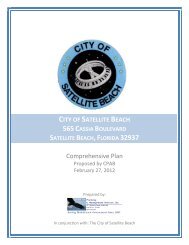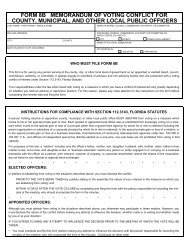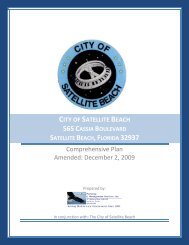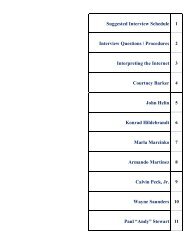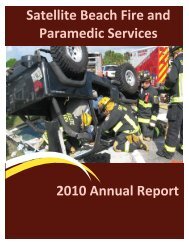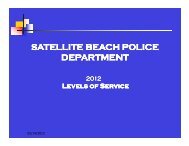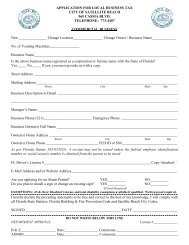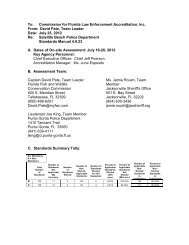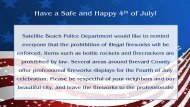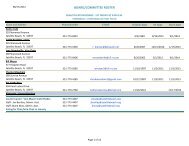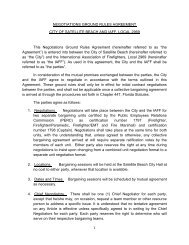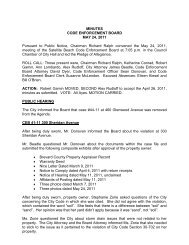Supporting Documents (Data and Analysis) - Satellite Beach
Supporting Documents (Data and Analysis) - Satellite Beach
Supporting Documents (Data and Analysis) - Satellite Beach
Create successful ePaper yourself
Turn your PDF publications into a flip-book with our unique Google optimized e-Paper software.
<strong>Beach</strong> Erosion<br />
The beach erosion rate, as determined by research undertaken for the preparation of the Brevard<br />
County <strong>Beach</strong> Management Plan (1987), averaged 0.5 feet per year between 1972 <strong>and</strong> 1985. Studies<br />
commissioned by the US Army Corps of Engineers <strong>and</strong> Brevard County have documented long-term<br />
loss of oceanfront l<strong>and</strong> in the City. Historical data indicate the location of the top of the dune bluff is<br />
retreating at a rate of about 0.6 foot per year, with the mean high tide line along the beach retreating<br />
at a rate of about 0.3 foot per year. Comparison with surveys conducted in 1844 <strong>and</strong> 1859 suggests<br />
that in the century-<strong>and</strong>-a-half since that time there has been slight net accretion (perhaps 50 to 150<br />
feet) of l<strong>and</strong> between Patrick Air Force Base <strong>and</strong> the northern end of the City, little change in the<br />
shoreline in the portion of the City north of Cassia Boulevard, <strong>and</strong> loss of as much as 1,700 feet (0.3<br />
mile) in the vicinity of Volunteer Way.<br />
Stormwater outfalls from SR A1A <strong>and</strong> some private residences also cause erosion in the vicinity of<br />
the structures. Surface water drainage onto the beach is a violation of the City Code <strong>and</strong> State<br />
regulations. As renovations are made to the properties drained by these outfalls, they will be<br />
removed so as to comply with Code <strong>and</strong> regulations. The apparent rise in sea level will also continue<br />
to cause dune migration westward along the entire beach.<br />
Habitats <strong>and</strong> Vegetative Cover<br />
The green sea turtle (threatened) <strong>and</strong> the loggerhead <strong>and</strong> leatherback turtles (endangered) nest along<br />
the stretch of beach in <strong>Satellite</strong> <strong>Beach</strong> <strong>and</strong> both to the north <strong>and</strong> south of the City. The beach<br />
provides habitat <strong>and</strong> food for ghost crabs <strong>and</strong> mole crabs as well as several bird species such as<br />
willets, plovers, s<strong>and</strong>erlings, terns, pelicans, <strong>and</strong> gulls. That portion of the beach from the foredune<br />
to mean low water exposed at low tide overlies a coquina shelf which forms irregular outcrops along<br />
the shoreline.<br />
The Brevard County, Florida Shore Protection Project Review Study Feasibility Report completed in<br />
1995 by the US Army Corps of Engineers reports that the coquina outcrops total approximately 32<br />
acres in the area between Patrick Air Force Base <strong>and</strong> Paradise <strong>Beach</strong> Park in Indialantic, with the<br />
best developed portion in the area immediately off <strong>Satellite</strong> <strong>Beach</strong>. In the same report, the US Fish<br />
<strong>and</strong> Wildlife Service reports that approximately 5 to 10 percent of these outcrops are inhabited by the<br />
reef-building tube worm Phragmatopoma lapidosa, citing the reef-rock habitat as "a unique<br />
biological feature of importance to the marine exosystem." The presence of the coquina outcrops,<br />
tube worms, <strong>and</strong> associated biological community of 350-plus identified species <strong>and</strong>, perhaps,<br />
another 350 yet to be identified (personal communication, Dr. Walter Nelson, Florida Institute of<br />
Technology) has resulted in a decision by those investigating beach renourishment south of Port<br />
Canaveral to not place s<strong>and</strong> on the beaches between Patrick Air Force Base <strong>and</strong> Paradise <strong>Beach</strong> Park.<br />
Vegetated s<strong>and</strong> dunes are found along most of the beach's length <strong>and</strong> provide the major defense<br />
against storm events. Native plant species found on the dunes include sea oats, palmetto, sea grape,<br />
railroad vine, dollar weed, coral bean, Spanish bayonet, wax myrtle, yaupon holly, <strong>and</strong> several grass<br />
species. More salt-tolerant <strong>and</strong> wind-tolerant species, such as sea oats <strong>and</strong> railroad vine, are found<br />
predominantly on the ocean side of the dune, while other dune vegetation species do not generally<br />
Coastal Management/Conservation Element<br />
<strong>Data</strong> <strong>and</strong> <strong>Analysis</strong> 5-3



